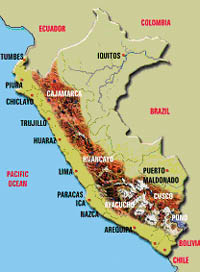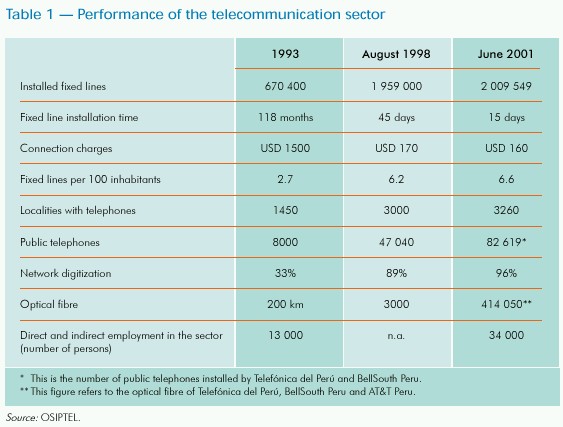Effective regulation
Peru
country case study
Peru is the fourth in a series of five country case studies
on regulatory independence and effectiveness to be presented in ITU News
Why Peru?
Peru, situated on the western side of
Latin America, covers an area of 1.28 million km². In mid-2000, the country had
an estimated population of over 27 million.
 With an annual per capita gross domestic
product (GDP) of USD 2500, the Peruvian economy is dominated by the services (45 per cent) and
industrial (42 per cent) sectors, with agriculture accounting for only a small
part (13 per cent). Telecommunication services amount to 3.1 per cent of GDP. With an annual per capita gross domestic
product (GDP) of USD 2500, the Peruvian economy is dominated by the services (45 per cent) and
industrial (42 per cent) sectors, with agriculture accounting for only a small
part (13 per cent). Telecommunication services amount to 3.1 per cent of GDP.
On deciding to privatize the State-run telecommunication
enterprises in the early 1990s, the Peruvian Government embarked on a programme
to reform the sector. It began by setting up a regulatory body in the form of
the Supervisory Authority for Private Investment in Telecommunications (Organismo
Supervisor de Inversión Privada en Telecomunicaciones — OSIPTEL). At the
end of the decade, it took another major step in the reform process by opening
up the telecommunication market to full and unrestricted competition.
With privatization and the award of 240 licences to 209
companies, the advent of the private sector in telecommunications brought with
it a considerable amount of investment and innovation in business management,
generating the rapid development of new services and marked improvements in
existing ones (see Table 1).
What is OSIPTEL?
The Organismo Supervisor de
Inversión Privada en Telecomunicaciones was established by Legislative
Decree No. 702 of 1991. OSIPTEL was the first regulatory body to be set up in
Peru, and began operations in 1993. It is a decentralized public body attached
to the Office of the President of the Council of Ministers, enjoying internal
public law status and administrative, functional, technical, economic and
financial independence. To enable it to carry out its functions, authority is
vested in OSIPTEL for regulation and standard-setting, remedies and penalties,
and dispute settlement.
Unlike other Latin American countries, Peru created a
regulatory body before privatizing its State-run telecommunication companies.
Although OSIPTEL reports to the Office of the President of the Council of
Ministers, two government bodies have a say in telecommunication issues: the
Ministry of Transport, Communication, Housing and Construction (MTC)
(Directorate-General for Telecommunications and Specialized Unit for
Telecommunication concessions) and the Ministry of Economy and Finance (MEF)
both of which appoint a representative to OSIPTEL’s Governing Board.
 Independence and transparency Independence and transparency
The fact that it is attached to the
Office of the President of the Council of Ministers is a significant
factor in OSIPTEL’s structural and institutional independence, since
accountability to a high-level political body with little incentive to control
the regulatory authority affords it protection from the sort of political
vicissitudes to which ministries are very often exposed.
Its independence is also protected from private interests
thanks to the mechanisms that govern staff recruitment and separation. Someone
who in the previous six months has worked in a company regulated by OSIPTEL is
not eligible for recruitment. Similarly, a former employee may not join any
company in the sector for a full year after leaving OSIPTEL.
International experience so far has shown that whatever the
institutional or legal mechanisms put in place to ward off threats to a
regulatory authority’s decision-making independence, transparency in
day-to-day practice is undoubtedly the most effective safeguard of that
independence.
|
Principles that guide the activity of
the regulatory authority in the performance of its duties
According to OSIPTEL’s General
Regulations, its practices and activities must be based on the following
principles:
-
Free access: OSIPTEL must guarantee
operating companies and users free access to public telecommunication
services.
-
Neutrality: OSIPTEL must ensure
neutrality in the operation of enterprises within its jurisdiction, taking
care that they do not use their position, either directly or indirectly, to
obtain advantages over other telecommunication service operators or over
users.
-
Non-discrimination: OSIPTEL must
ensure that companies operating in public telecommunication services markets
are not discriminated against.
-
Cost-benefit analysis: Before
embarking on any activities, OSIPTEL must carry out an analysis of their
costs and benefits, backed up by studies and technical evaluations showing
their rationality and efficiency.
-
Transparency: The decision-making
bodies of OSIPTEL must adopt their decisions on the basis of criteria which
are predictable and accessible to those under its jurisdiction.
-
Promotion of competition: OSIPTEL’s
policy must be to encourage investments that will enhance the coverage and
quality of public telecommunication services by gearing its activities to
the promotion of free and fair competition.
-
Impartiality: When considering the
interests of service operators and users, OSIPTEL must act fairly and
impartially in strict compliance with the relevant standards.
-
Independence: In the performance of
its functions, OSIPTEL shall not be subject to any compulsory order of any
other State body or entity.
-
Subsidiarity: OSIPTEL’s activity
is subsidiary in that it arises only insofar as freely competitive markets
and mechanisms fail to meet adequately the interests of users and
competitors.
-
Supplementarity: The rules of free
competition are supplementary to whatever standards and/or regulations are
issued by OSIPTEL in the performance of its duties.
-
Analysis of functional decisions:
This must take account of the effects of such decisions on tariffs, quality,
incentives for innovation, contractual conditions and any other areas
relevant to market development and the satisfaction of users’ interests.
-
Efficiency and effectiveness:
OSIPTEL’s activities shall be guided by the search for efficiency in the
assignment of resources and the achievement of objectives at the lowest cost
to society as a whole.
-
Expeditiousness: In carrying out
its administrative duties, OSIPTEL must endeavour to resolve problems and
disputes in the best and most expeditious manner.
|
OSIPTEL has numerous mechanisms to guarantee transparent
decision-making. Some of the main ones are: advance publication of decisions;
public hearings; consultation of interested parties; public access to all
OSIPTEL documents; prior publication on the Web of the Governing Board’s
meeting agendas; a website providing plentiful statistical and regulatory
information, reference documents and annual reports (www.osiptel.gob.pe). What
is more, OSIPTEL is the first State body to have incorporated a clause on
transparency in its regulations that applies to all staff in their daily
activities and decision-making (see box).


Lurin Earth station (Peru)
Photos: A.
de Ferron (ITU 910015) |
In terms of institutional practice, OSIPTEL can be said to
have broken new ground, being the first State body to write transparency into
its internal rules.
OSIPTEL’s budget consists mainly of compulsory
contributions from the companies it regulates. The contribution, paid monthly,
amounts to 0.5 per cent of the company’s gross revenue of the previous month.
In order to secure access to public telecommunication
services for as many people as possible, OSIPTEL provides, as a matter of
principle, users with guidance in fulfilling their rights and obligations. This
policy is reflected in its procedures for claims. Claims may be submitted in
person or in writing — Response and Guidance Service (SAO) — or by telephone
using the helpline “Fono Ayuda”. Claims are initially filed with the service
provider. Cases not resolved at that stage are referred to OSIPTEL’s
Administrative Tribunal for the Settlement of User Claims (TRASU).

Cellular telephone in Cuzco (Peru)
(ITU
980150) |
The quality of human resources is a key element in a
regulatory body’s ability to perform efficiently the duties assigned to it.
Strict selection and ongoing training and motivation of staff are therefore
among OSIPTEL’s priority objectives. After starting out at the end of 1993
with only 16 staff members, by 1996 OSIPTEL’s staff had reached a total of 120
and has remained stable since then. Of these, 76 are university graduates, 16 of
whom hold postgraduate qualifications.
Conclusion
OSIPTEL’s considerable achievements
are largely due to the principles on which it operates and the continuity
of its management. Ever since it was founded, OSIPTEL has received consistent
support directly from the President of the Nation with a view to keeping it
independent of other State bodies. The fact that it comes under the Office of
the President of the Council of Ministers has been a significant factor in its
structural and institutional independence.
A more detailed analysis of OSIPTEL’s effectiveness as
regulator, its independence and its activities can be found on the ITU/BDT
website at www.itu.int/ITU–D/treg/Case_Studies/Index.html
| Contributed by Jorge Crom, Director, Atlantic Consulting and
Ben A. Petrazzini, Policy Adviser, ITU/SPU. |
|
 With an annual per capita gross domestic
product (GDP) of USD 2500, the Peruvian economy is dominated by the services (45 per cent) and
industrial (42 per cent) sectors, with agriculture accounting for only a small
part (13 per cent). Telecommunication services amount to 3.1 per cent of GDP.
With an annual per capita gross domestic
product (GDP) of USD 2500, the Peruvian economy is dominated by the services (45 per cent) and
industrial (42 per cent) sectors, with agriculture accounting for only a small
part (13 per cent). Telecommunication services amount to 3.1 per cent of GDP. Independence and transparency
Independence and transparency

